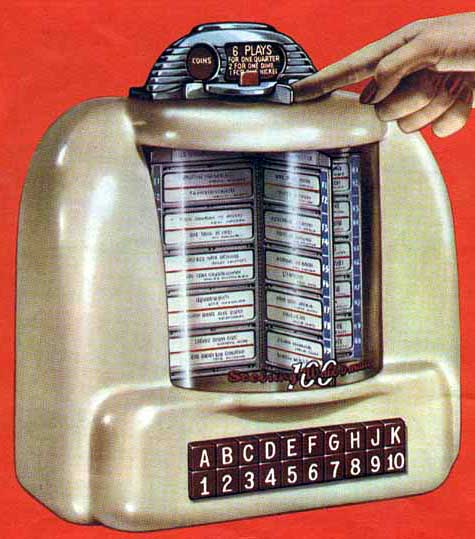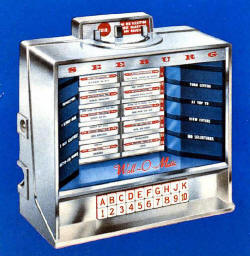 | The famous 3W1 Wallbox. 100 Selections. The 3W1 'Wall O Matic' was introduced along with the M100A jukebox (first ever 100 selection mechanism, 78rpm) in 1948 as a 1949 model. The original version had the same red keyboard (numbers--letters) as the M100A. They were solid red with the letter or number embossed in the plastic, and filled with a white paint. The next version was introduced in 1949, along with the M100B, the first 45rpm jukebox ever produced. Both the phono and the Wall-O-Matic featured the translucent type keys, which have the white caps outlining the red letters/numbers (as shown at left) and in the 3W1, is back lit, with two small lamps. Even though the competitors introduced their own versions of the Wallbox, all manufacturers eventually offered a stepper compatible with the 3W1. The name comes from the number of wires required to connect the Wallbox to the jukebox: 3. Two of the wires were for power (24 VAC and ground). The other sent the selection as a series of pulses to ground. The pulses were used to repeatedly energize a relay in the remote control stepper (standard equipment in some Seeburg jukes, optional in others), which in turn wrote the selection into the jukebox's memory. The last version of the 3W1 featured blue title strip holder pages, and an improved lock to attach them to the Wallbox, both of which were carried over to the 3W100 model, see below. 3W1D: uses the same style cabinet as the 3W1, but was factory set for 10 cent (Dime) play. The coin acceptor had a nickel flipper which flipped every other nickel past the coin switch, thus requiring two nickels to be inserted for one credit. Thanks to Ron Rich for providing most of the above information. Books applicable to this machine: None |
 | From the original M100A brochure, this is a scan of the beige-finished 3W1 Wallbox. Later versions were chrome-plated. Scan courtesy Hildegard Stamann. Books applicable to this machine: None |
 | 3W100 Wallbox. 100 Selections. A styling update of the 3W1. AP3W1: was the same as the 3W100, except that the front glass has 'Artist of the Week' silk-screened across the top, where as the 3W1D said 'Seeburg', and it had a connector available for an optional headset that could be used to hear your selection. This optional headset, and the hanger for it was part of a kit, sold separately. In addition to the headset, it required the purchase of a Stereo Headset Control (one control for up to 20 Wallboxes), and the use of eight-wire cable. The audio was only available during the two-scan cycle of the phonograph. Another selection would need to be made after the jukebox motor stopped, in order to be heard at an individual Wallbox, same as for the later Consolette speakers. Pricing on all of the "100" series Wallboxes was adjustable to a degree, by the operator. Thanks to Ron Rich for providing most of the above information. Books applicable to this machine: None |
 | 3WA Wallbox. 200 Selections. Introduced at the same time as the 200-selection V200, the new Wallbox was needed to handle the increased number of selections. At least seven 200-selection Wallboxes were made. They are: V-3WA-N, V-3WA-D: The difference between the -N and -D models was the pricing setup. The -N was set for nickel play (single = 5�, EP = 10�, using the DCU Pricing Unit). The -D was dime play (single = 10�, EP = 15�, using the DCU-10 Pricing Unit. The pricing on these and the following models was fixed at the factory. It could not be changed without new parts or jury-rigging. D-3WA, D-3WU: Both of these were set at 10 cents for a single. 'U' indicated a universal model, which could be used on 100, 200, or 160-play jukeboxes. Changing from a 200/160 to a 100-selection model required replacing the number stickers to correspond to the system used on the 100-select models. The stickers were included with the Wallbox. These models came with 'tie backs' that would lock all unused pages from turning. Changing to a 160 only required using the tie backs, and ignoring the 9 and 0 buttons on the keyboard. A clip was inserted into the keyboard, preventing 9 and 0 from being pushed for the 160-plat version. For the 100-play version, the clip prevented the L through V buttons from being pushed. Both models were equipped with the DPU-10 Pricing Unit. The 'D' stands for Dual Pricing. S-3WA, S-3WU: This Wallbox was single pricing only (the 'S' stands for Single). The customer was required to make selections after depositing each coin. The pricing setup could be changed on this mode, without using new parts. S-3WU was a single pricing version of the 3WU.
HD-3WA, HD-3WU: The two HD units were almost the same as the other Dual Pricing units, except that the coin acceptor now took the half dollar. The upper section of the cover was different, as was the coin entry. Thanks to Ron Rich for providing all of the above. Books applicable to this machine: None
|
 | 3W160 Wallbox. 160 Selections. Specifically designed to handle the new 160-selection machines. D-3W160: Dual pricing, using the DPU10. S-3W160: Single pricing. Thanks to Ron Rich for providing all of the above. Books applicable to this machine: None
|
 | SC, SCH Consolettes: Price (October, 1963) $265. Introduced at the same time as the LPC1 Console was the Stereo Consolette or SC1. Three models were produced. The SC1 had a chrome finish (shown at left). The SC-2 had an antique bronze finish, and the SC-3 had a Golden finish. See the following photo. The SCH models were produced as a chrome finish(-1) and SCH-2, an antique bronze. They were introduced along with the SS160 phonograph (1965 introduction for 1966 model year), and can be distinguished from the SC series as having a larger coin entry to accommodate the U.S. half-dollar coin. They are NOT backwards compatible with the SC models due to revised audio control circuits. They can be used on a separate circuit; one additional wire must be added to the ten wire cable to use these on the same jukebox as the SC models, if you want all the features to operate. They will not operate with older jukeboxes unless the juke itself is modified. The SCH also differed in that it would accept half-dollar coins (the 'H' in SCH), while the SC models took only nickels, dimes and quarters. They had a pair of speakers built in, so that you could hear your selection, and at the same time control the volume. Also included was the ability to remotely keep track of the amount of money in each Consolette, recorded on the optional Remote Income Totalizer, a box located in the Console. When Seeburg introduced these units, they decided to make them as incompatible as possible with the older 3W1, 3W100, 3WA, and 3W160 Wallboxes, to guarantee that the competitor's Wallboxes would not work. To do this, the order of selection transmission was reversed, and the number of pulses output for each letter and number selection was changed. It was relatively straightforward to 'reprogram' the Remote Control Stepper to handle these changes, but the wiring inside the earlier Stepper was too short to do so easily. After a couple of years of major complaints by the operators this was fixed, and instructions were included in the Stepper kit showing how to covert for 3Wx use. With the introduction of the Black and Gray box machines, Books applicable to this machine: |
| Left-to-Right: SC1, SC3, SC2. Photo courtesy Kevin Green.
Books applicable to this machine: | |
 | Text below and photo at left provided by Kevin Green: This is an EBCS2 (Extended Bass Consolette Speaker). The EBCS1 had a different finish (Walnut Grain Decarlite for the 1, same as the LPC1 cabinet, and Planked Cherry Decarlite for the 2, same as the LPC480 cabinet so the colors would match on location), they had different bass ports, and the interior layout is different. Inside, there's a fluorescent light, a Stereo Network, and a single 8" woofer. The EBCS1 had a rectangular hole sawn in the panel next to the speaker with a (presumably wooden) box projecting back to serve as the bass port. When they designed the EBCS2, they realized that drilling two circular holes and jamming sections of cardboard tubing into them was cheaper and easier. The EBCS1 had a Cam-Action Terminal Strip inside for ease of wiring, and the EBCS2 didn't. In any case, the EBCS was sold without the Consolette attached. Any of the SC or SCH Consolettes could be installed onto it, as could the DECs (although I assume this thing was discontinued before the black and gray box machines came along). The Consolette is connected to the phonograph in the normal manner, then the Consolette speaker 'hot' wires are disconnected. Five wires are run up through the bottom of the Consolette from the EBCS Stereo Network. These are ground, Left and Right input, and Left and Right output. By connecting it in this fashion, the Audio Control Relay can be used to turn the Consolette speakers and the EBCS speaker on and off, and the volume control in the Consolette will also work for both. There are three LLP (Little LP) frames behind the glass, which are the same parts used in the LPCs. One interesting thing is that the front door which holds the speaker and the album frames is exactly the same part as the LPC1 front speaker/door, but it is turned on its side. When I got this EBCS2, the chrome was hopelessly pitted, and I bought an LPC1 front door to replace it. Of course, the Consolette is powered in the conventional way, and the fluorescent light plugs in to the wall. 25" Wide, 34" High, 10" Deep. This at first seems like a totally absurd idea -- after all, the Consolette is supposed to be small and compact. What's the point of making it much bigger? I assume it's because so many bars and restaurants have both a main room and a back room. If your patrons are gathered in the back room drinking and playing pool, they don't want to trudge out to the main room to play music, so the EBCS would be a perfect solution for getting more dimes and quarters out of their pockets. Books applicable to this machine: |
 |
Books applicable to this machine: |
 | Books applicable to this machine: |
| Photo Needed! | There was also an Extended Bass Consolette Speaker stand for the DEC-series Consolettes, that included a Dollar Bill Validator. It looked similar to the EBCS1 & 2, see above. Anyone having a photo or more information on this, please contact me, and I'll post them here, giving credit. |
|
| This is a picture of the prototype VMC Consolette, taken from the VMC brochure. I believe there was only one built, the working prototype used for this photo. The Consolette was designed to use the same board as the top control board of the VMC, with a smaller thumbwheel and pushbutton board and a 9-inch monochrome monitor to display selection and location info. Books applicable to this machine: None |
class="F4 Bold FontArial Black"

